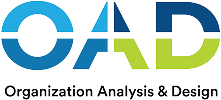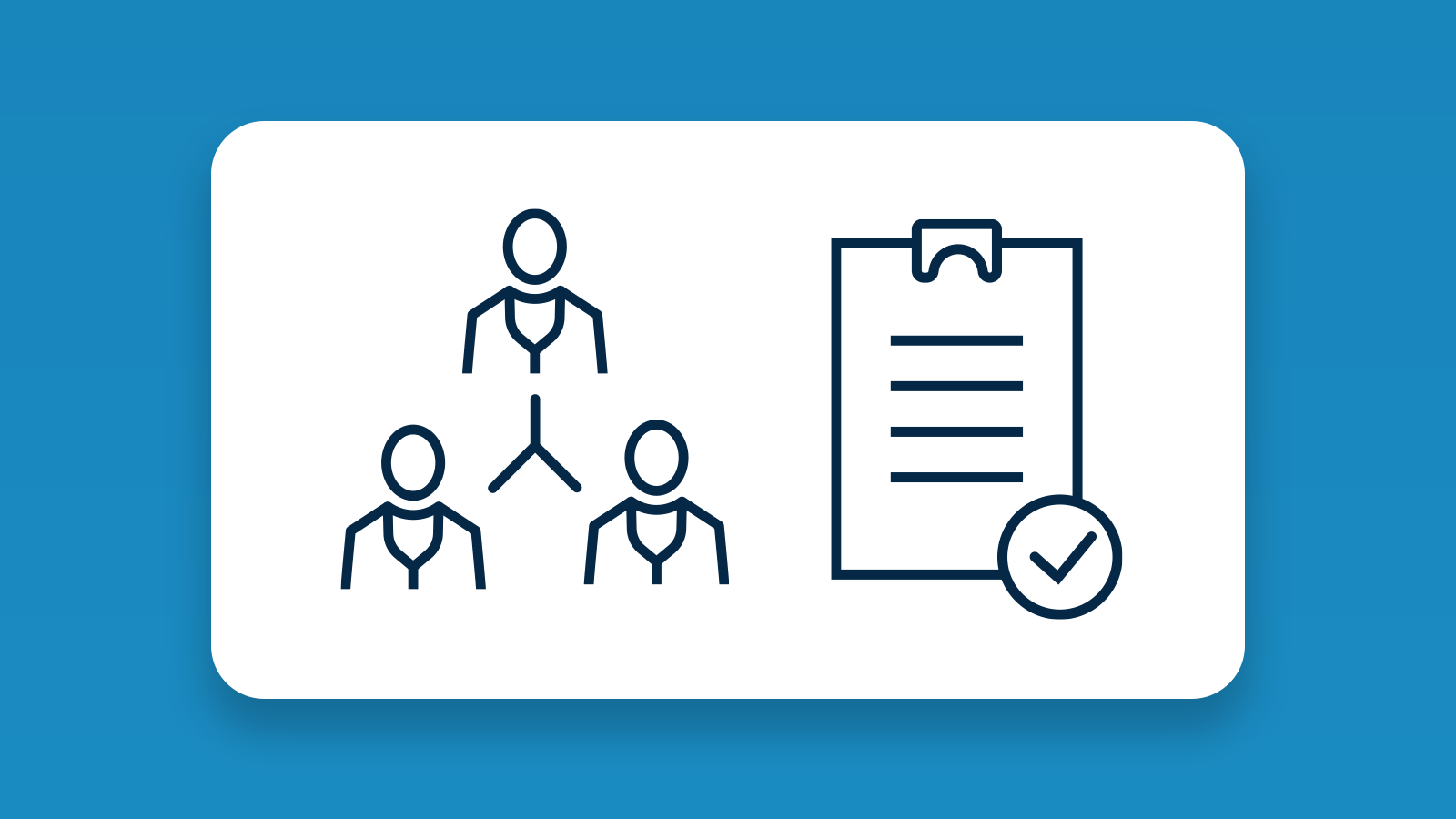Employee turnover isn’t just disruptive—it’s expensive. Studies show replacing a single employee can cost 6–9 months of their salary, draining resources and slowing growth. The good news? With the right candidate assessment tools, HR leaders can predict performance more accurately, hire smarter, and cut turnover in half.
Table of Contents
- What Are Candidate Assessment Tools?
- Why Traditional Hiring Methods Fail
- How Assessment Tools Predict Job Performance
- Types of Candidate Assessment Tools That Work
- The Science Behind Lowering Turnover
- How Hiring Managers and Teams Benefit
- Best Practices for Assessment
- Building a Comprehensive Assessment Strategy
- Real-World Examples and Leadership Lessons
- Key Takeaways for HR Leaders
- Ready to Cut Turnover in Half?
Candidate Assessment Tools: What Turnover Really Costs Companies
Replacing a single employee can cost up to 213% of their annual salary, depending on the role (SHRM). Beyond direct expenses like recruitment and training, turnover also drags down team morale and productivity. For companies with 50+ employees, even a handful of bad hires each year translates into millions in hidden costs.

Why Hiring Managers Struggle Without Reliable Data
Most hiring teams still rely heavily on resumes, gut instinct, and unstructured interviews. But research shows these methods predict job performance only 14% of the time (Schmidt & Hunter, 1998). Without data-driven assessments, hiring becomes a gamble—one that often leads to unqualified candidates slipping through the process.
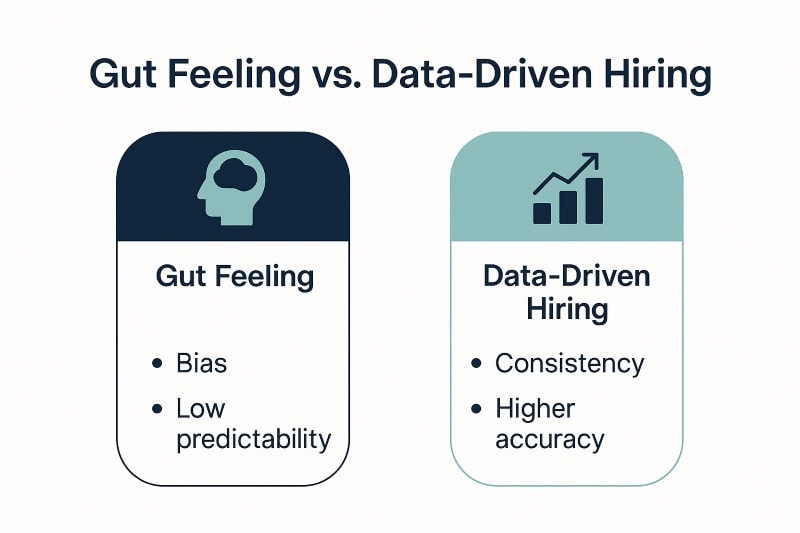
Case in Point: Leadership Lessons
Jeff Bezos famously insisted on hiring only “bar-raisers”—candidates who elevated the company’s talent pool. Elon Musk, meanwhile, has said he’d rather work with a smaller team of exceptional people than a large team of average performers. Both leaders underscore the same principle: better hiring decisions compound over time. And that begins with smarter candidate assessment.

What Are Candidate Assessment Tools?
Defining Candidate Assessment Tools
Candidate assessments are various methods and tools used in hiring, designed to evaluate skills, personality traits, and job fit—far beyond what resumes or interviews reveal. These tools support comprehensive candidate evaluation by helping hiring managers make consistent, data-driven hiring decisions and predicting how candidates will perform in real-world scenarios.
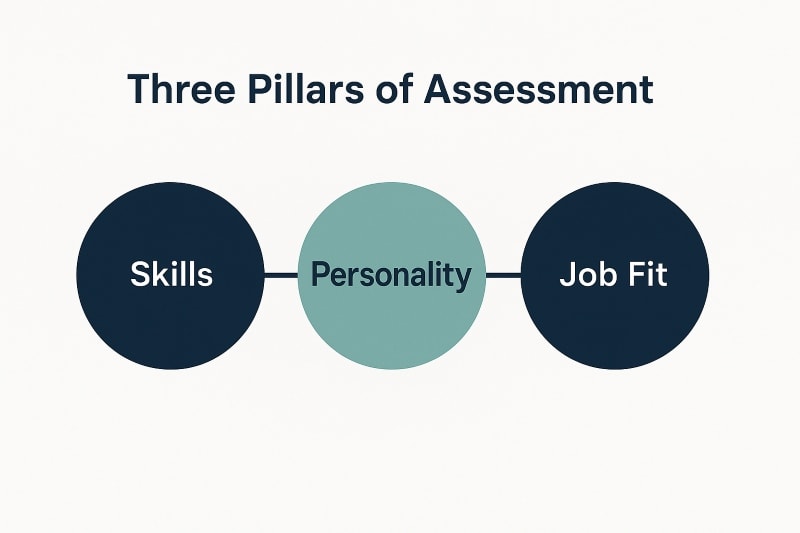
These tools help assess candidates for both skills and fit, ensuring a thorough and objective hiring process.
From Technical Skills to Soft Skills
Modern assessment tools measure everything from technical abilities (coding skills, specific technical skills, language proficiency, role-specific tests) to soft skills (these tools assess soft skills such as communication, adaptability, emotional intelligence, and problem-solving). When combined, they create a fuller picture of each candidate’s potential.
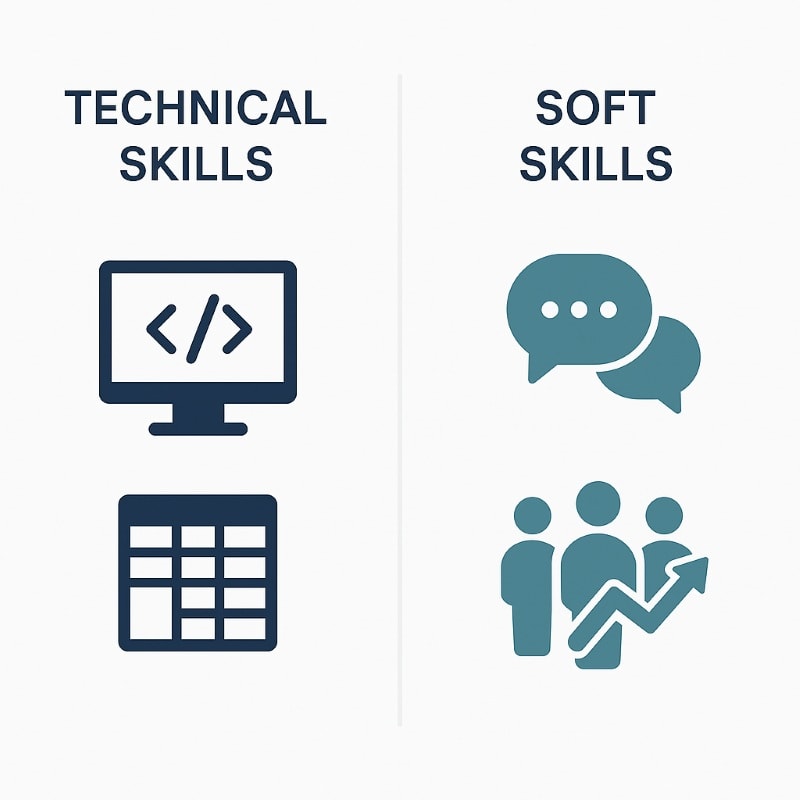
The Evolution of Hiring Platforms
What once meant a simple skills test has now evolved into a comprehensive assessment ecosystem—a modern hiring platform and comprehensive assessment platform that serves as an all-in-one solution for evaluating a wide range of skills, from technical and cognitive to personality traits. Today’s platforms include:
- AI-powered assessments that analyze candidate responses for deeper insights.
- Game-based assessments that measure problem-solving under pressure.
- Automated scoring systems that remove human bias.
- Seamless integration with your applicant tracking system (ATS) and other recruiting tools, ensuring synchronization with existing recruiting software and job boards to streamline the hiring process.
The result? Faster evaluations, better data, and a stronger candidate experience.
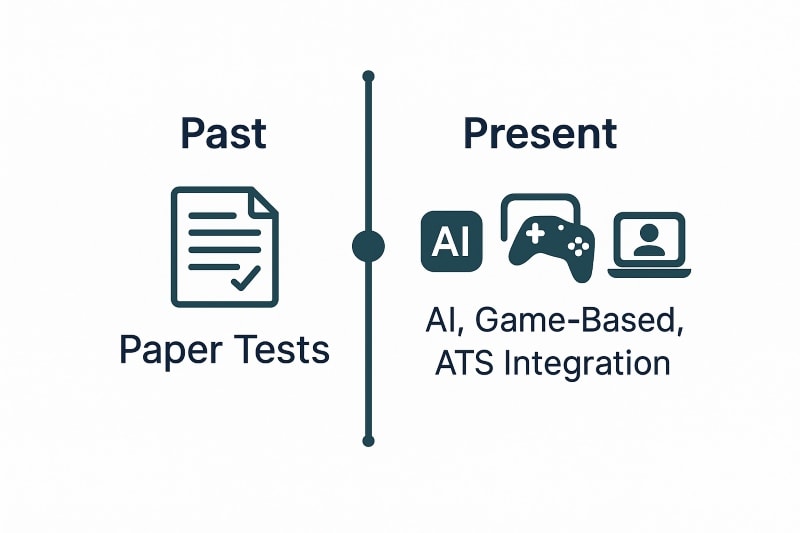
Why Traditional Hiring Methods Fail
Over-Reliance on Resumes and Interviews
Resumes give only a surface-level view of a candidate’s abilities, and interviews are often inconsistent. Studies show unstructured interviews predict job performance less than 20% of the time (Schmidt & Hunter, 1998). Without standardized assessments, companies risk overlooking qualified candidates—or worse, hiring unqualified ones.

The Problem with “Gut Feeling” Hiring Decisions
Hiring managers often pride themselves on intuition, but gut decisions are prone to unconscious bias. These biases can disadvantage entire groups of applicants while giving a false sense of confidence in the hiring process. Worse, they often lead to inconsistent evaluation standards across the hiring team.

Data Shows the Limits of Traditional Methods
A landmark study analyzing 85 years of hiring research found that resumes and unstructured interviews were among the least predictive hiring tools. In contrast, structured methods like cognitive tests, work samples, and behavioral assessments were far more accurate predictors of job performance. In other words, the science is clear: relying solely on outdated methods means gambling with every hire.

How Assessment Tools Predict Job Performance
Cognitive Ability Tests and Job Performance Correlation
Research consistently shows that cognitive ability tests are among the strongest predictors of workplace success. They measure how candidates process information, solve problems, and adapt to new challenges—all critical to long-term performance. When combined with other assessments, cognitive tests help hiring managers identify high-potential talent with greater accuracy.

Personality Traits and Culture Fit
Technical skills get candidates in the door, but personality traits often determine whether they stay. Assessments that measure work style, motivation, and interpersonal tendencies reveal whether someone will thrive within a company’s culture and align with the overall company culture. OAD’s behavioral frameworks, for example, identify how natural traits align—or clash—with specific job roles.
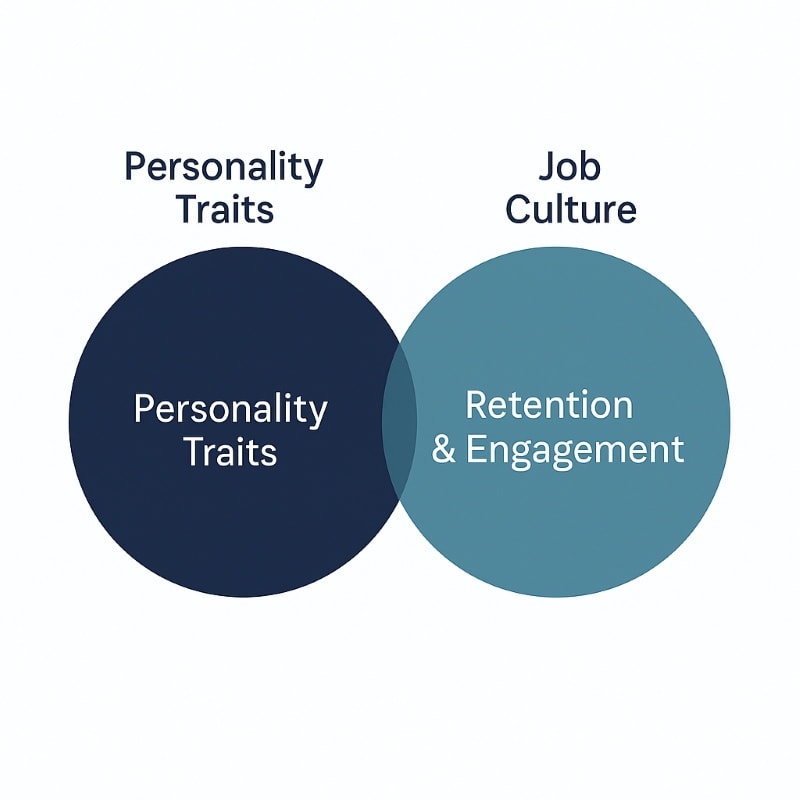
Emotional Intelligence and Communication Skills
Employees with strong emotional intelligence (EQ) build stronger teams, manage conflict more effectively, and adapt during high-pressure situations. Assessments that measure EQ and communication skills don’t just predict performance—they forecast leadership potential and long-term retention. According to TalentSmartEQ, 90% of top performers score high in emotional intelligence.
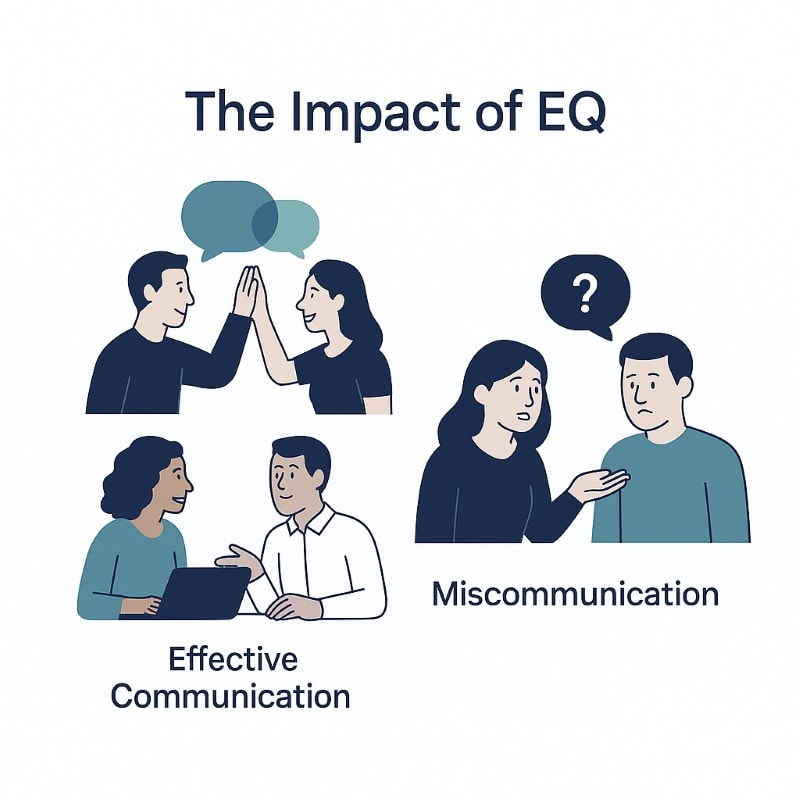
Why Thorough Job Analysis Matters
Even the best assessments fail if they don’t match the job. A thorough job analysis ensures companies test for the right competencies—whether it’s technical ability for software developers or interpersonal skills for client-facing roles. Without this alignment, assessments risk measuring “interesting” traits rather than relevant predictors of performance.

Types of Candidate Assessment Tools That Work
Pre-Employment Assessments
Pre-employment assessments, a key category of candidate assessments, provide an objective snapshot of a candidate before they join your team. These can include cognitive ability tests, personality assessments, technical skill evaluations, and skills tests. When applied early in the hiring process, they help filter out unqualified candidates and save the hiring team valuable time.
Candidates complete these assessments online, with results automatically scored, ranked, and displayed to streamline evaluation and decision-making.
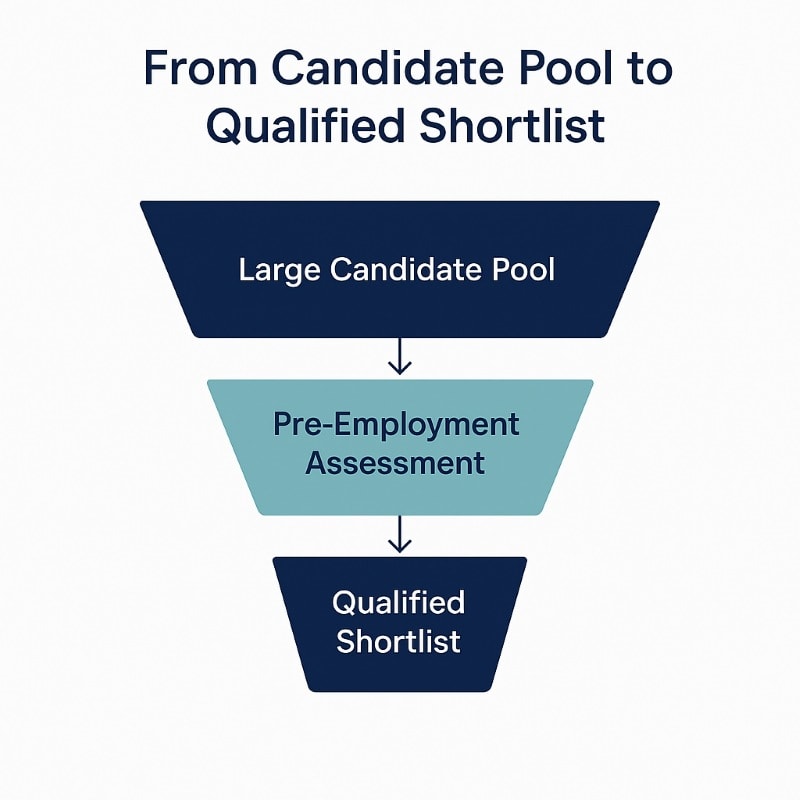
Job Simulations and Situational Judgment Tests
Unlike traditional tests, job simulations put candidates in real-world scenarios to demonstrate how they’d handle challenges on the job. Similarly, a situational judgment test (SJT) is a key assessment tool that presents candidates with workplace dilemmas to evaluate their decision-making, problem-solving, and to assess soft skills such as communication, adaptability, conflict resolution, and leadership. These tools are powerful because they predict on-the-job performance more accurately than resumes or interviews.

Behavioral Assessments and Structured Interviews
Behavioral assessments measure personality traits, communication styles, and leadership potential—factors critical for long-term cultural fit. When combined with structured interviews (where every candidate is asked the same standardized questions), hiring teams reduce unconscious bias and gain comparable data across applicants.

AI-Powered Assessments
AI-powered assessments are rapidly transforming high-volume hiring. By analyzing candidate responses, facial cues in video interviews, or written test results, these tools provide automated candidate scoring at scale. They help hiring managers quickly identify top talent without sacrificing quality—though transparency and fairness remain critical. Additionally, robust assessment security features such as live proctoring and screen recording help ensure test integrity and prevent cheating, making these solutions especially valuable for critical or sensitive roles.

Game-Based and Interactive Assessments
To engage modern candidates, many companies now use game-based assessments. These tools measure problem-solving, memory, and adaptability in real time while creating a positive candidate experience. By blending science with interactivity, they not only evaluate candidates but also leave a lasting impression of the employer brand.

The Science Behind Lowering Turnover
Data-Driven Hiring Decisions vs. Gut Instinct
When companies replace gut instinct with data-driven hiring, the results are immediate. According to a Harvard Business Review study, organizations using structured, science-backed assessments are 36% more likely to improve employee retention. Data transforms hiring from a gamble into a repeatable, scalable process.
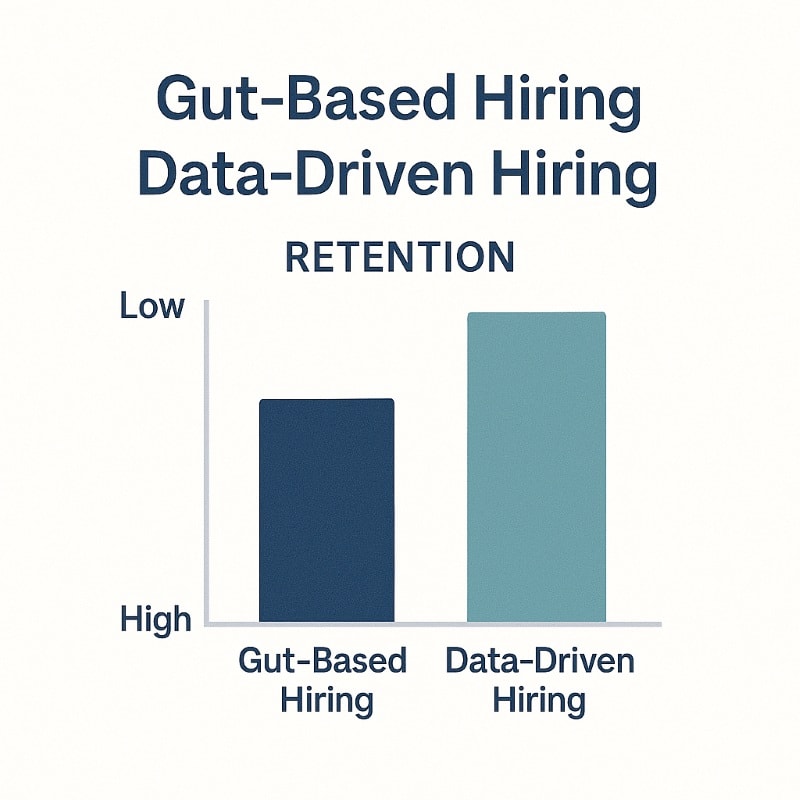
Why Better Assessment Outcomes Mean Stronger Retention
Assessments reduce the risk of unqualified candidates slipping through while ensuring high-potential hires are not overlooked. Employees who are matched to roles based on validated assessments tend to feel more engaged, more productive, and less likely to leave. In other words, the right tools not only fill seats—they keep the right people in them.

Gallup Research on Engagement and Performance Alignment
Gallup’s research shows that employees who feel well-matched to their roles are 3.5 times more likely to be engaged at work. And engagement is the single strongest predictor of retention. By aligning assessments with job analysis, companies ensure every new hire isn’t just qualified—they’re motivated to stay.
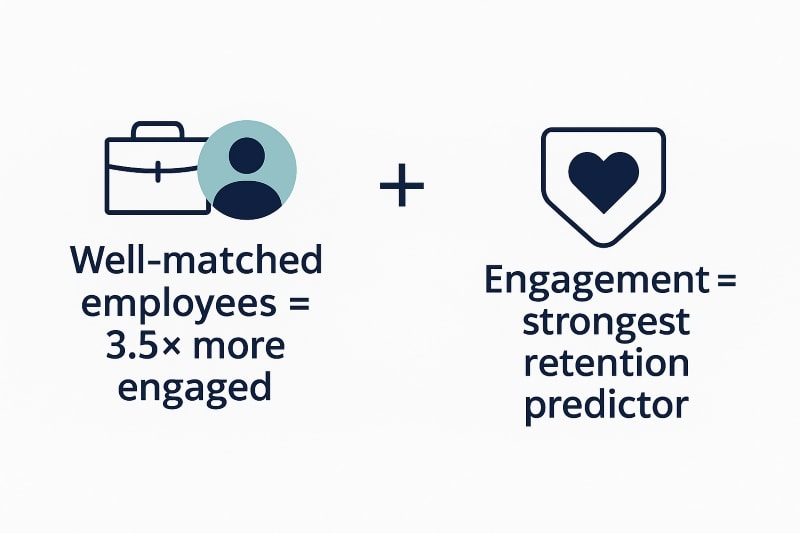
Case Examples of Reduced Turnover Through Talent Assessments
In practice, companies that adopt comprehensive assessment platforms consistently report reduced turnover rates. For example, one global retail chain found that integrating behavioral and cognitive assessments into its process cut first-year turnover by 30%. Similar case studies across tech, healthcare, and manufacturing point to the same truth: better assessments equal better retention.
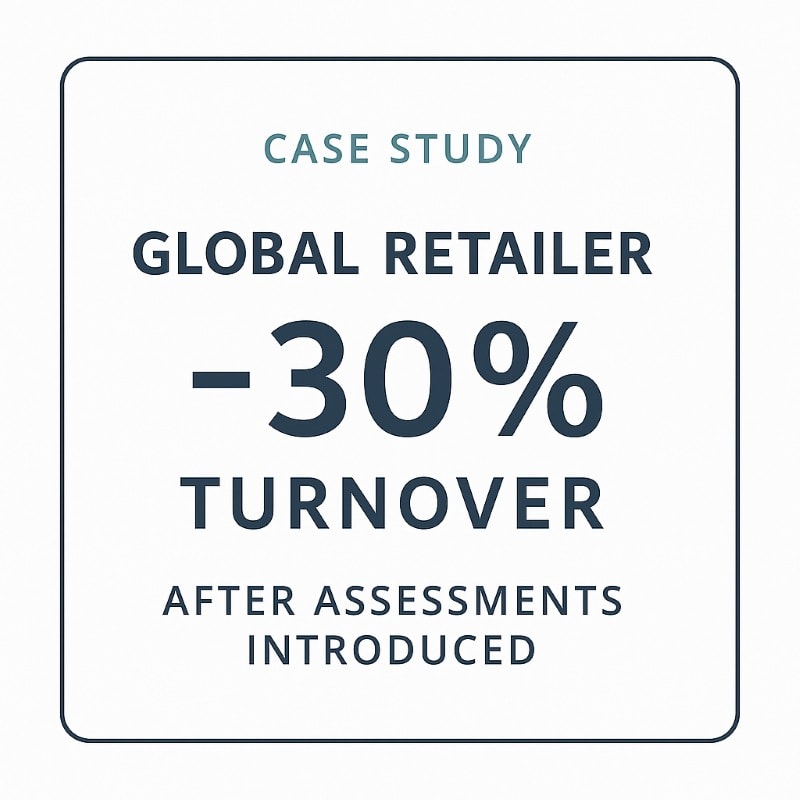
Candidate Experience Still Matters
Balancing Rigor with Fairness
The most effective assessment tools are both scientifically rigorous and candidate-friendly. Overly long or poorly designed tests can frustrate applicants, leading top talent to drop out of the hiring process. That’s why modern tools emphasize both test integrity (to ensure valid results) and a streamlined candidate experience.

Transparent Communication Throughout the Hiring Process
Transparency is critical to building trust. Candidates want to know why they’re being assessed, how the results will be used, and what it means for their application. Clear communication reduces anxiety and boosts candidate confidence, which in turn improves their perception of your company—even if they aren’t ultimately hired.

Why Top Talent Values a Structured and Fair Evaluation Process
High performers actually welcome structured assessments because they showcase their abilities in a fair, consistent environment. Unlike unstructured interviews where bias can creep in, validated tools level the playing field. When candidates feel evaluated on merit, they’re more likely to accept offers and stay engaged long after onboarding.

How Hiring Managers and Teams Benefit
Faster Alignment Within the Hiring Team
Without assessments, hiring teams often rely on subjective impressions, leading to long debates and inconsistent decisions. Standardized assessment data creates a shared language across HR and hiring managers. This accelerates decision-making and reduces costly delays in the recruitment process.
Improved Collaboration Across HR and Hiring Managers
Assessments provide objective benchmarks that bridge the gap between HR leaders, recruiters, and hiring managers. Instead of debating opinions, teams can evaluate candidates against the same criteria, improving collaboration and building confidence in final hiring decisions.
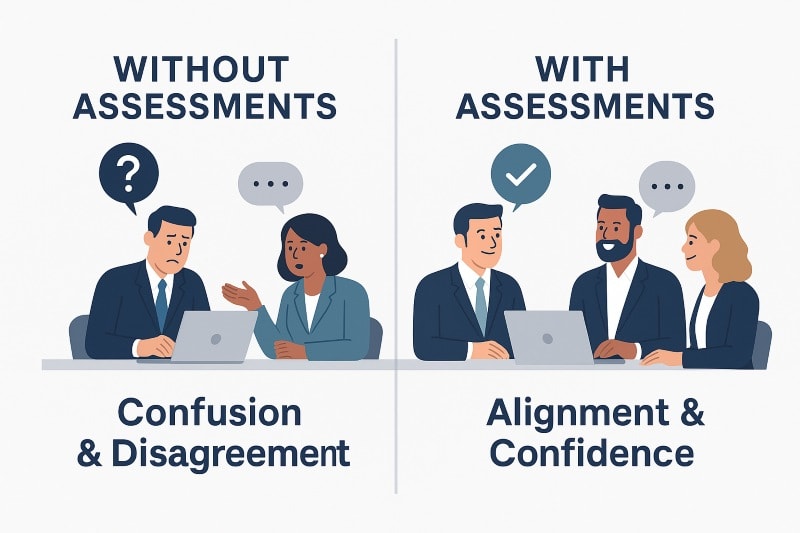
Reduced Bias and More Confident Hiring Decisions
When hiring teams use behavioral assessments, structured interviews, and automated scoring, they minimize unconscious bias and gain confidence in their final decisions. This not only leads to higher-quality hires but also strengthens diversity and inclusion efforts by ensuring candidates are evaluated fairly.

Best Practices for Assessment
Ensuring Validity and Reliability
For hiring managers, the foundation of effective candidate assessment lies in tools that are both valid and reliable. Validity means your assessments are measuring what truly matters—skills, competencies, and personality traits that directly predict job performance. Reliability ensures those results remain consistent, no matter when or how often the assessment is administered.
Achieving this starts with a thorough job analysis to pinpoint the exact requirements of each role. From there, select assessment tools that have been scientifically validated and proven to predict performance across industries. Just as important, regularly review and update your tools to reflect evolving roles, new technologies, and changing workforce demands.
By prioritizing validity and reliability, hiring managers gain more than just accurate data—they gain the confidence to identify top talent, reduce turnover, and make hiring decisions that drive long-term success.
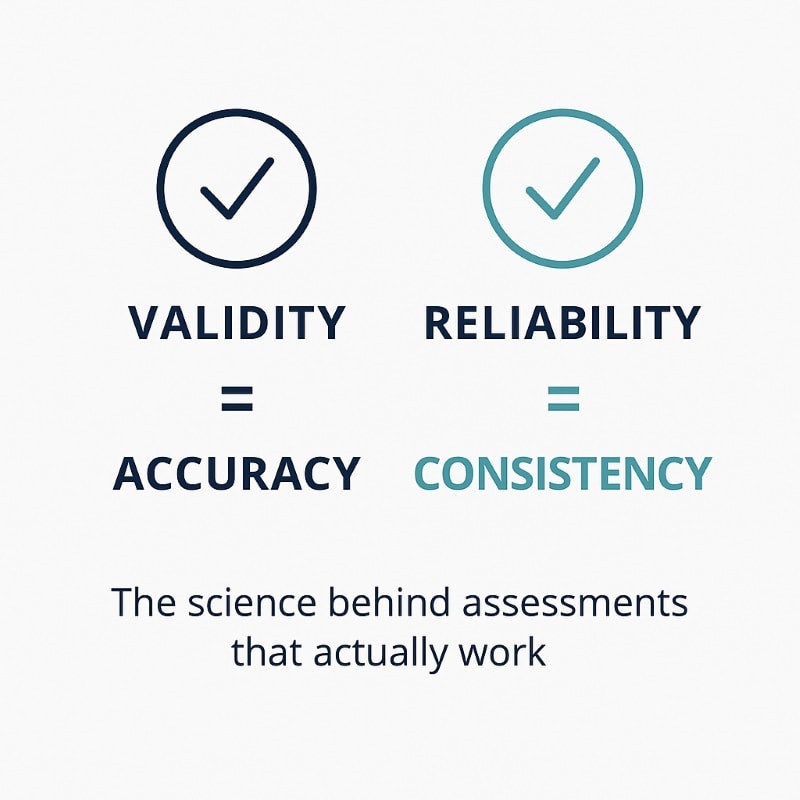
Avoiding Adverse Impact and Bias
A fair and inclusive hiring process doesn’t happen by accident—it requires deliberate design. Adverse impact occurs when an assessment unintentionally disadvantages certain groups, while bias can creep in through poorly designed questions or inconsistent administration. Both lead to flawed hiring outcomes and damage trust in the process.
To minimize these risks, hiring teams should choose assessment tools that are rigorously tested for fairness and inclusivity. Every candidate should have equal access, clear instructions, and support when needed. Just as important, organizations should regularly audit assessment outcomes to spot unintended barriers or disparities.
By fostering transparency and equity throughout the hiring process, HR leaders ensure that candidates are evaluated on their true potential—not on irrelevant factors. The result is not only better hiring decisions, but also a more diverse and resilient workforce.

Integrating Assessments Seamlessly into the Hiring Process
The best assessment tools don’t just deliver insights—they fit naturally into the entire hiring process. For hiring managers, seamless integration ensures efficiency, while for candidates it creates a smooth, professional experience.
By leveraging applicant tracking systems (ATS) that work hand-in-hand with assessment platforms, companies can make assessments feel like a natural step in recruitment. Candidates complete evaluations without friction, while hiring teams benefit from automated scoring and consolidated data—all in one workflow.
Clear communication is equally critical. Candidates should know what assessments to expect, how long they’ll take, and how results factor into the hiring decision. This transparency builds trust and strengthens employer branding.
When assessments are woven seamlessly into the recruitment process, HR leaders reduce manual steps, shorten time-to-hire, and improve candidate experience—all while accurately identifying top talent.
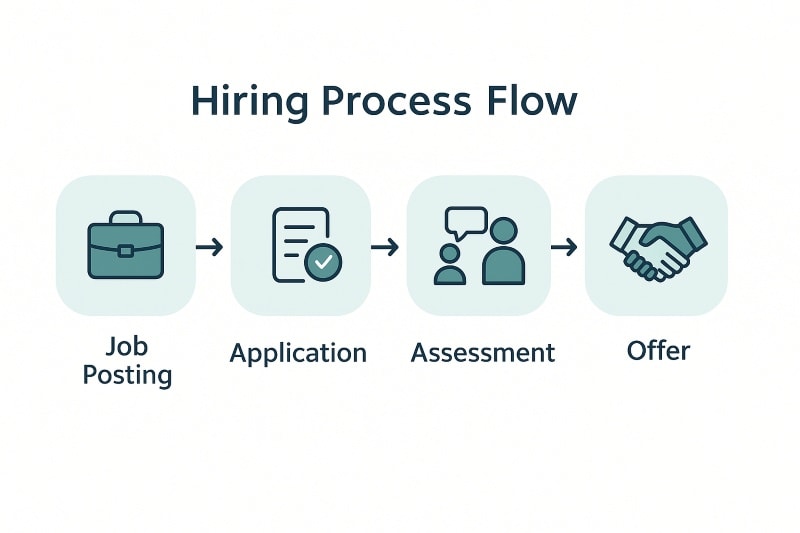
Training Hiring Teams on Assessment Interpretation
Even the most advanced assessment tools are only as effective as the people using them. Without proper training, hiring managers risk misinterpreting results or overlooking critical insights. That’s why it’s essential to equip hiring teams with the skills to analyze and apply assessment data effectively.
Training should cover how to:
- Interpret candidate scores and reports with confidence.
- Recognize high-potential performers and spot early red flags.
- Combine assessment insights with structured interviews, reference checks, and job analysis to make well-rounded decisions.
Equally important, training must address bias awareness—ensuring hiring teams rely on data rather than subjective impressions. Ongoing education keeps evaluation practices consistent, fair, and scientifically grounded.
When hiring teams are trained to interpret assessments correctly, companies gain higher-quality hires, greater confidence in decisions, and a more reliable hiring process.

Building a Comprehensive Assessment Strategy
Step 1 — Conduct a Thorough Job Analysis
Every strong assessment strategy begins with a clear understanding of the role. Job analysis identifies the core competencies, technical skills, and personality traits required for success. Without this foundation, assessments risk measuring irrelevant qualities.
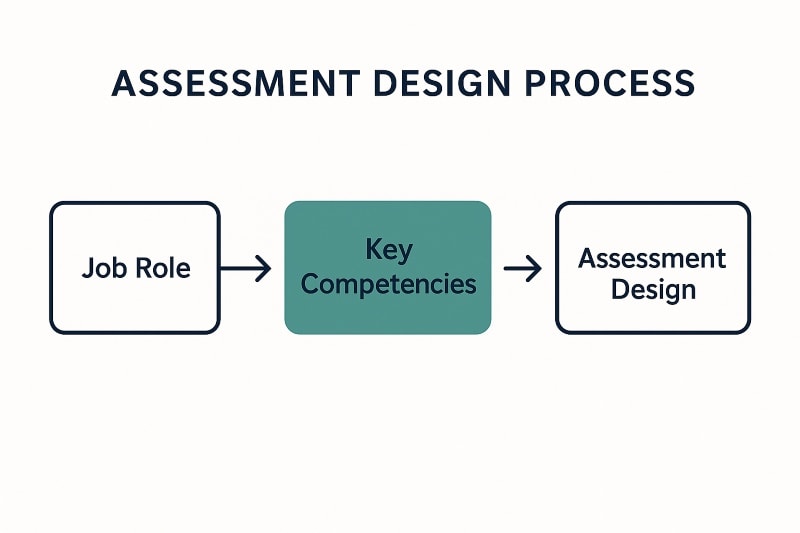
Step 2 — Customize Assessments for Role-Specific Skills
Generic tests can miss what really matters. A software developer may need coding challenges, while a customer success manager may require communication and problem-solving assessments. Tailoring assessments ensures candidates are measured against the actual demands of the role.
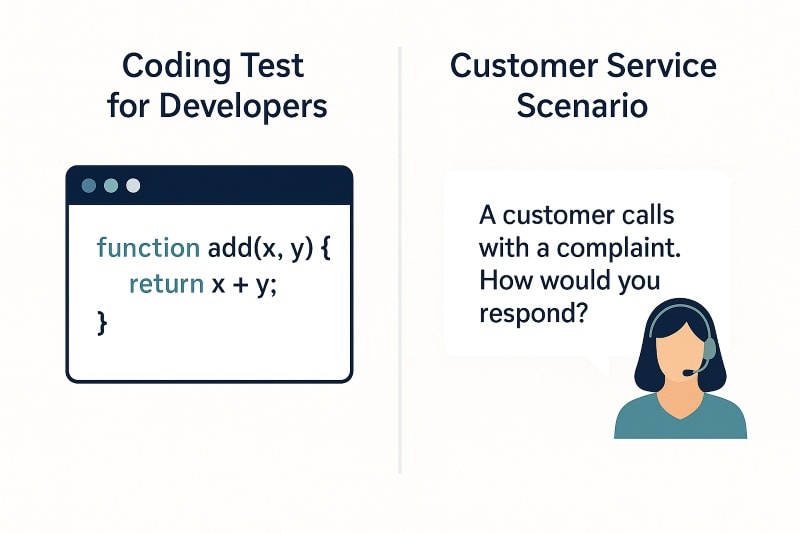
Step 3 — Integrate with Applicant Tracking Systems (ATS)
To avoid friction, assessments should integrate seamlessly with existing hiring platforms and applicant tracking systems. This allows HR teams to manage everything from applications to scoring in one place, improving efficiency and visibility.

Step 4 — Validate Assessment Outcomes with On-the-Job Performance
Assessment results mean little without validation. The most effective companies regularly compare assessment outcomes with actual job performance to ensure accuracy. Over time, this feedback loop strengthens predictive power and improves hiring decisions.
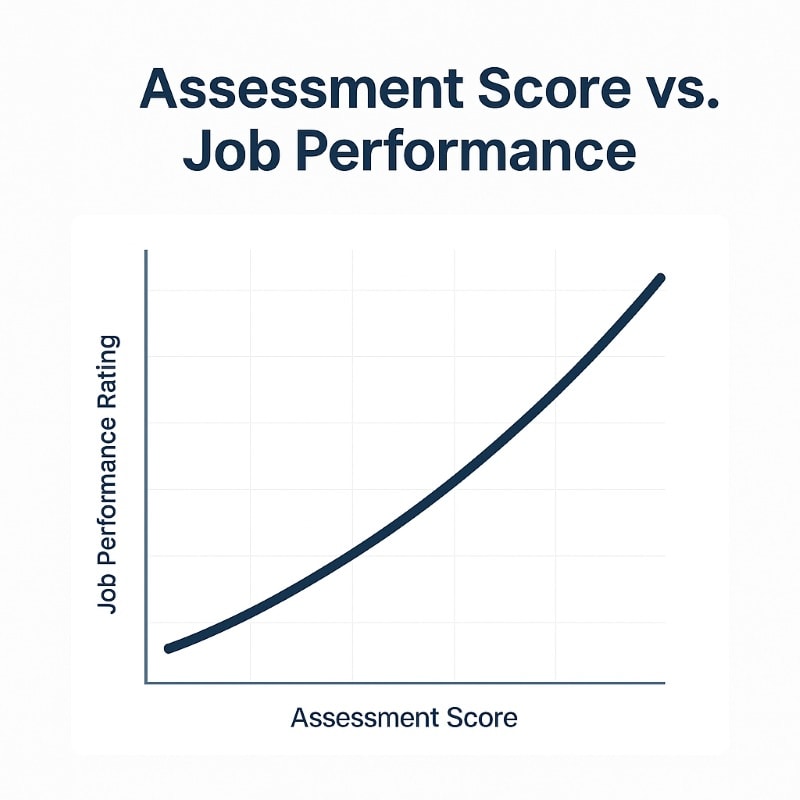
Step 5 — Continuously Improve with Assessment Insights
A strong assessment strategy is never static. By regularly analyzing results, tracking turnover, and reviewing assessment effectiveness, companies can adapt their tools to evolving roles and workforce needs. This continuous improvement cycle ensures the hiring process stays both competitive and fair.
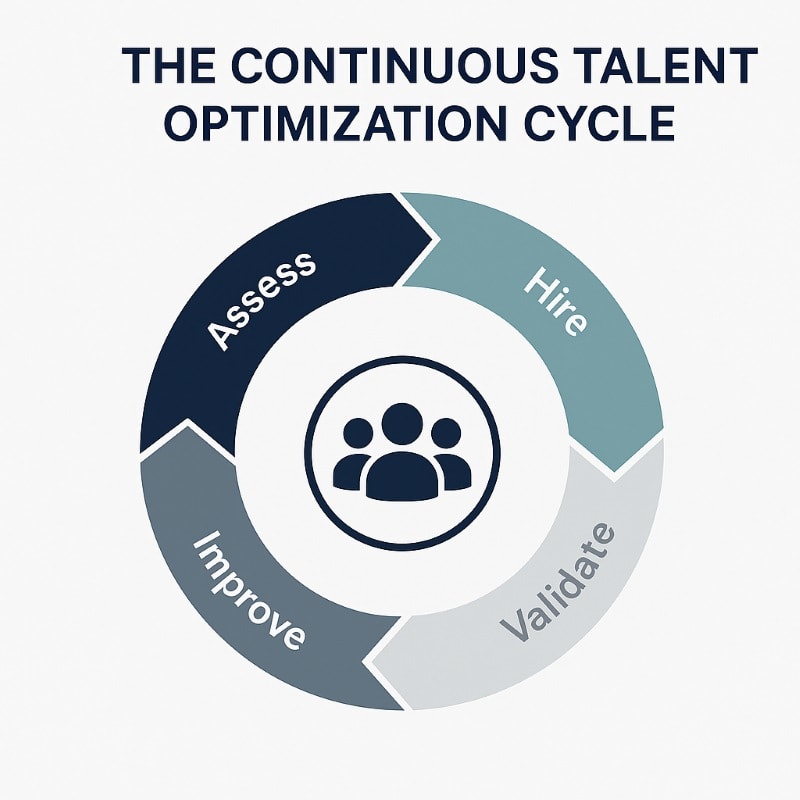
Real-World Examples and Leadership Lessons
How Top Companies Use Talent Assessment Tools
Amazon built its reputation on the “bar-raiser” program, ensuring every new hire raised the company’s overall talent level. Google, meanwhile, pioneered structured interviews backed by behavioral science, leading to more consistent and fair hiring decisions. Both companies show that rigorous assessment processes are key to maintaining performance at scale.

Lessons From Business Leaders
Warren Buffett has long said he hires for integrity, intelligence, and energy—and warns that without integrity, the other two traits are dangerous. Howard Schultz of Starbucks emphasizes cultural alignment as critical to long-term retention. These philosophies echo what science shows: assessments must evaluate more than skills—they must capture values, behaviors, and personality traits that determine fit.
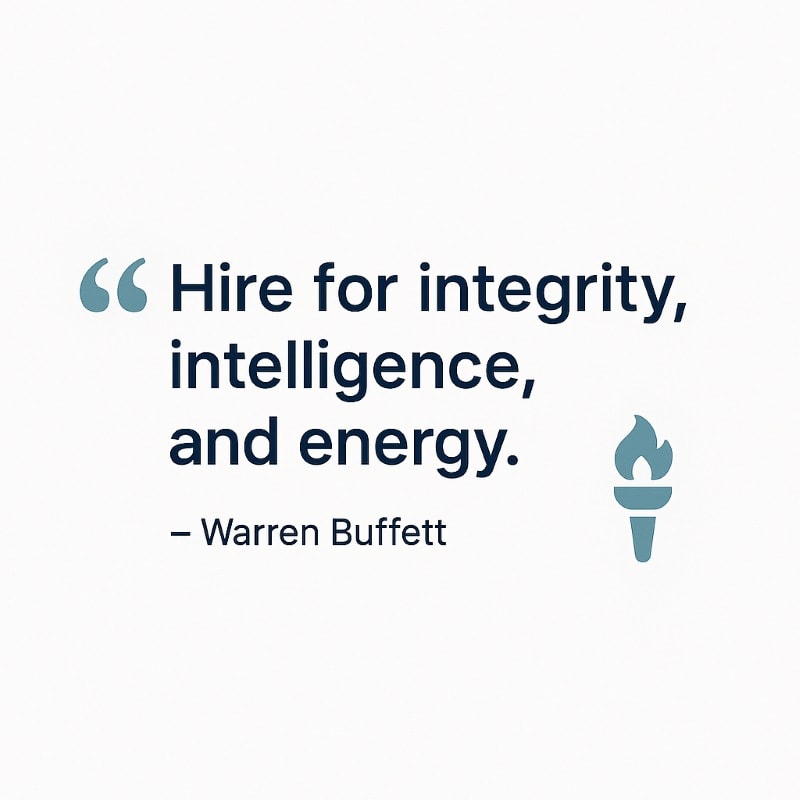
OAD’s Science-Backed Advantage
But while Amazon and Google have massive resources to build custom hiring systems, most companies don’t. That’s where OAD makes the difference. Backed by decades of behavioral science, OAD’s assessments predict job performance, team alignment, and long-term retention—with a level of precision validated by research. In other words: OAD delivers the predictive power of Big Tech hiring in a platform accessible to every HR leader.

Key Takeaways for HR Leaders
Why Candidate Assessment Tools Are No Longer Optional
In today’s competitive labor market, relying solely on resumes and gut instinct is a recipe for high turnover. Science-backed candidate assessment tools have proven to reduce mis-hires, increase retention, and strengthen culture. For HR leaders, these tools aren’t an add-on—they’re a strategic necessity.
The Bottom-Line Business Case
Employee turnover costs companies millions annually in recruitment, training, and lost productivity. By integrating tools like cognitive tests, behavioral assessments, and job simulations, organizations make data-driven hiring decisions that directly protect the bottom line. Hiring smarter isn’t just about people—it’s about profitability.
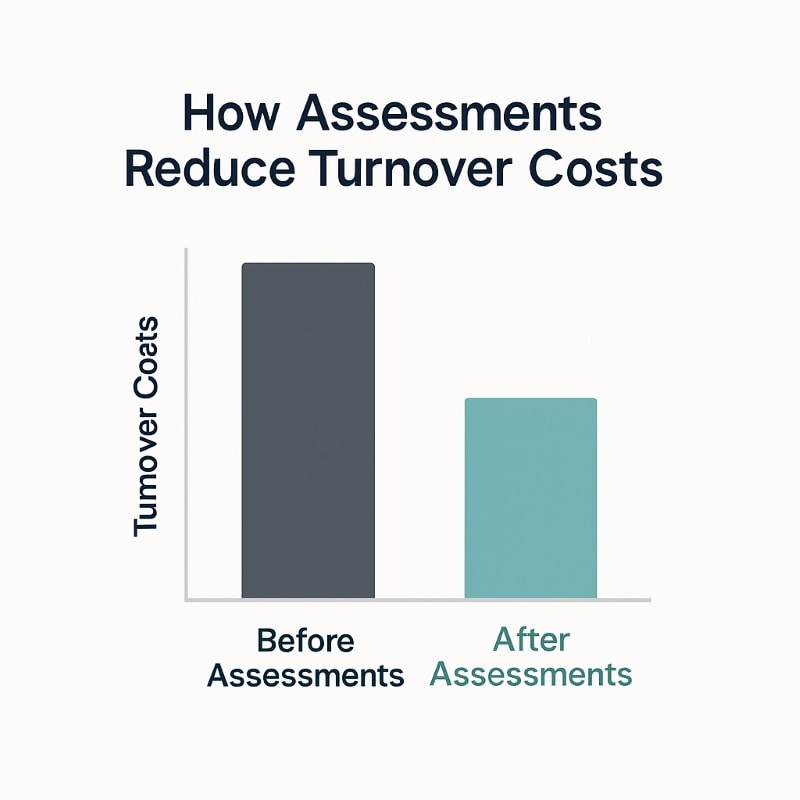
Future Trends in Candidate Assessment
The next generation of tools will be AI-powered, interactive, and bias-resistant. From game-based evaluations to automated candidate scoring, the future of hiring is about combining predictive accuracy with fairness and engagement. Forward-looking HR leaders who adopt these tools today will be best positioned to attract, hire, and retain top talent tomorrow.

Ready to Cut Turnover in Half?
Turnover is not just a hiring problem—it’s a profitability problem. Every mis-hire drains resources, disrupts teams, and slows growth. The companies that thrive aren’t the ones making gut-based hiring decisions. They’re the ones using data, behavioral science, and validated assessments to build stronger, more resilient teams.
Amazon has its bar-raisers. Google has its structured interviews. But you don’t need a Big Tech budget to achieve Big Tech results. With OAD’s scientifically validated platform, you can predict job performance, reduce mis-hires, and retain top talent—all without adding complexity to your hiring process.
If you’re ready to hire smarter, build stronger teams, and cut turnover in half, the next step is simple:
Test OAD for free today.
